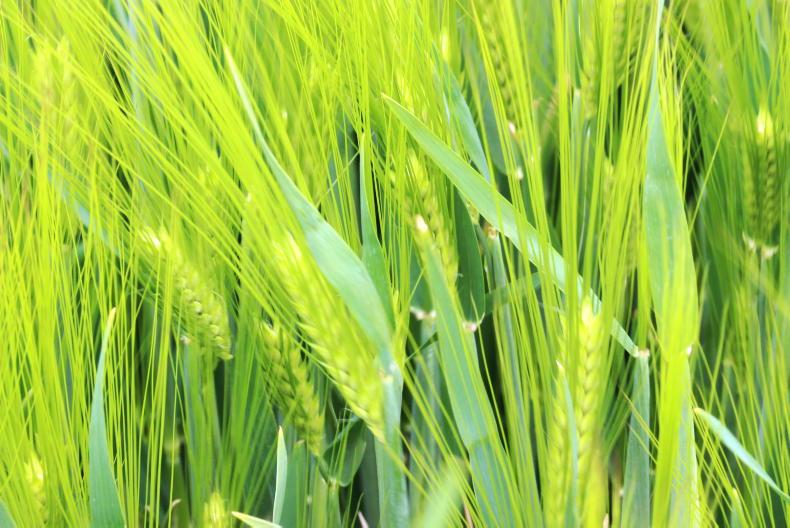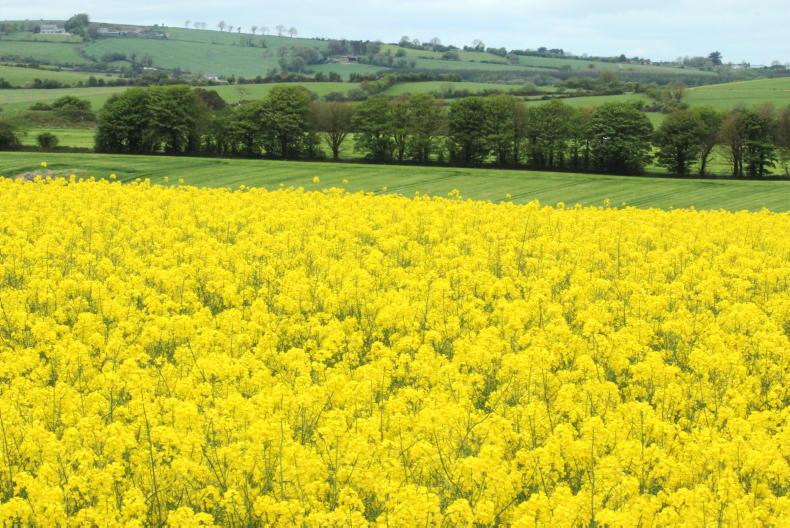For me there are few nicer sights than crops bulking up and filling out to show high yield potential. That is what I saw during my travels to Cork earlier this week, both along the road and in the fields I walked through.
Flag leaves out
Winter wheat crops were either side of GS39 with flag leaves fully emerged but still mainly upright.
Foliar disease levels were low with some fresh septoria and evidence of old mildew on the lower leaves. Virtually all crops were full and carrying a good colour.
The exception to this was the presence of virus in some fields. I say a virus because what I saw was not what I would call typical BYDV symptoms but rather some other virus symptom that may be more symptomatic of the CYDV mentioned by Louise McNamara in this year’s Crop Protection magazine.
These leaf symptoms were different to traditional BYDV, which I have seen in crops elsewhere this season. A level of dwarfing was evident, as was the pale yellow colour in infected patches. But yellowing symptoms were not uniform on all leaves on a stem.

The earliest crops of winter barley were heading out but other crops are barely at awns visible stage.
Normal symptoms would show a relatively clear demarcation between the start and finish of the yellow and green, but this was not the case in the crops I visited. The yellow area, often only on a single leaf, seemed to extend down into some interveinal spaces and not others, which made for a very ragged transition from yellow to green.
The severity of the symptoms I saw varied massively between fields and within fields. Infection level ranged from less than 5% to more than 20% in the worst affected areas of a field.
Winter barley and rape
Crops varied from no awns visible to ears emerging and were clean, strong and generally full, with some evidence of old mildew at the base. I saw no evidence of anything more than single stems with virus-affected leaves. There was definite evidence of a variety effect on development and earing out.

Winter rape is still in heavy flower but most of the pods have already been formed on the main rachieme.
Winter rape is now almost impossible to inspect as branches intertwine in the tram tracks. One crop I visited was very tall, probably well over one metre around the headland, and the plants were very clean, with leaves green to the ground.
This crop was about two-thirds of the way through flowering on the main racemes but some of the branches down in the canopy were still at the green flower-bud stage.
Mildew in spring oats
Some spring oat crops I saw had really bad mildew – levels indicative of soft growth and very high fertility. Some of the initial leaves had 70% to 80% mildew cover but it had not moved on to more recent growth. There was an occasional leaf with virus symptoms but again this was a single yellow leaf on a stem while other leaves looked to be perfectly green.
Most new leaves on this crop also showed yellow and green striations. This is sometimes indicative of rapid growth and emergence but this one seemed more like magnesium deficiency.
Spring barley more variable
Spring barley was the dominant crop and crops ranged from GS12 up to GS25, with GS13/14 being average. Most crops looked very well but some were somewhat uneven. This was partly an establishment issue, but compaction also looked to be a problem.
One field was still only emerging and crows had obviously been an issue. Another crop at GS13/21 looked under pressure and this too had uneven establishment.
Some of the headland areas had already been totally grazed by rabbits.
Spring and winter beans
Spring beans were at four- to six-true-leaf stage and generally well established. They look healthy but the recent rain was probably a big boost. One winter bean crop, which is now about 0.8m tall, was around mid-flowering stage and had been recently sprayed for disease.
Maize
There were quite a number of recently sown maize crops under plastic. Some of the plastic had already blown off in places.
There were also some maize crops sown without plastic and these had emerged with one leaf already fully exposed.
For me there are few nicer sights than crops bulking up and filling out to show high yield potential. That is what I saw during my travels to Cork earlier this week, both along the road and in the fields I walked through.
Flag leaves out
Winter wheat crops were either side of GS39 with flag leaves fully emerged but still mainly upright.
Foliar disease levels were low with some fresh septoria and evidence of old mildew on the lower leaves. Virtually all crops were full and carrying a good colour.
The exception to this was the presence of virus in some fields. I say a virus because what I saw was not what I would call typical BYDV symptoms but rather some other virus symptom that may be more symptomatic of the CYDV mentioned by Louise McNamara in this year’s Crop Protection magazine.
These leaf symptoms were different to traditional BYDV, which I have seen in crops elsewhere this season. A level of dwarfing was evident, as was the pale yellow colour in infected patches. But yellowing symptoms were not uniform on all leaves on a stem.

The earliest crops of winter barley were heading out but other crops are barely at awns visible stage.
Normal symptoms would show a relatively clear demarcation between the start and finish of the yellow and green, but this was not the case in the crops I visited. The yellow area, often only on a single leaf, seemed to extend down into some interveinal spaces and not others, which made for a very ragged transition from yellow to green.
The severity of the symptoms I saw varied massively between fields and within fields. Infection level ranged from less than 5% to more than 20% in the worst affected areas of a field.
Winter barley and rape
Crops varied from no awns visible to ears emerging and were clean, strong and generally full, with some evidence of old mildew at the base. I saw no evidence of anything more than single stems with virus-affected leaves. There was definite evidence of a variety effect on development and earing out.

Winter rape is still in heavy flower but most of the pods have already been formed on the main rachieme.
Winter rape is now almost impossible to inspect as branches intertwine in the tram tracks. One crop I visited was very tall, probably well over one metre around the headland, and the plants were very clean, with leaves green to the ground.
This crop was about two-thirds of the way through flowering on the main racemes but some of the branches down in the canopy were still at the green flower-bud stage.
Mildew in spring oats
Some spring oat crops I saw had really bad mildew – levels indicative of soft growth and very high fertility. Some of the initial leaves had 70% to 80% mildew cover but it had not moved on to more recent growth. There was an occasional leaf with virus symptoms but again this was a single yellow leaf on a stem while other leaves looked to be perfectly green.
Most new leaves on this crop also showed yellow and green striations. This is sometimes indicative of rapid growth and emergence but this one seemed more like magnesium deficiency.
Spring barley more variable
Spring barley was the dominant crop and crops ranged from GS12 up to GS25, with GS13/14 being average. Most crops looked very well but some were somewhat uneven. This was partly an establishment issue, but compaction also looked to be a problem.
One field was still only emerging and crows had obviously been an issue. Another crop at GS13/21 looked under pressure and this too had uneven establishment.
Some of the headland areas had already been totally grazed by rabbits.
Spring and winter beans
Spring beans were at four- to six-true-leaf stage and generally well established. They look healthy but the recent rain was probably a big boost. One winter bean crop, which is now about 0.8m tall, was around mid-flowering stage and had been recently sprayed for disease.
Maize
There were quite a number of recently sown maize crops under plastic. Some of the plastic had already blown off in places.
There were also some maize crops sown without plastic and these had emerged with one leaf already fully exposed.








 This is a subscriber-only article
This is a subscriber-only article










SHARING OPTIONS: